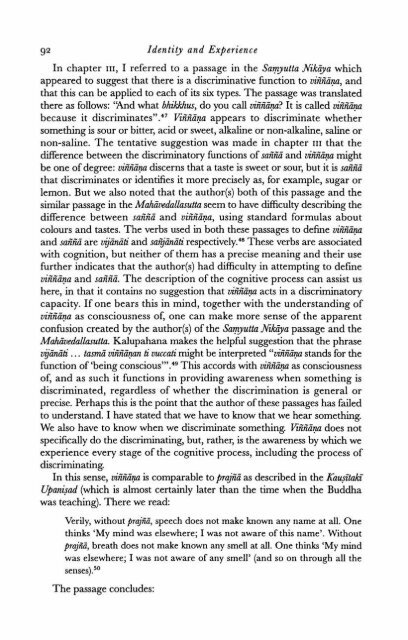Identity and Experience_Hamilton_1996
Identity and Experience_Hamilton_1996
Identity and Experience_Hamilton_1996
You also want an ePaper? Increase the reach of your titles
YUMPU automatically turns print PDFs into web optimized ePapers that Google loves.
92 <strong>Identity</strong> <strong>and</strong> <strong>Experience</strong><br />
In chapter 111, I referred to a passage in the Samyutta NiklZya which<br />
appeared to suggest that there is a discriminative function to vifiiitipz, <strong>and</strong><br />
that this can be applied to each of its six types. The passage was translated<br />
there as follows: "And what bh.ikkhus, do you call vin"n"tiy? It is called vin"n"tiy<br />
because it discriminate^".^' Vin"n"tina appears to discriminate whether<br />
something is sour or bitter, acid or sweet, alkaline or non-alkaline, saline or<br />
non-saline. The tentative suggestion was made in chapter 111 that the<br />
difference between the discriminatory functions of saii7ii <strong>and</strong> vin"n"tipz might<br />
be one of degree: vin"n"iv discerns that a taste is sweet or sour, but it is san"n"ti<br />
that discriminates or identifies it more precisely as, for example, sugar or<br />
lemon. But we also noted that the author(s) both of this passage <strong>and</strong> the<br />
similar passage in the Mh-r)edallmtta seem to have difficulty describing the<br />
difference between san"Cti <strong>and</strong> vifiiitina, using st<strong>and</strong>ard formulas about<br />
colours <strong>and</strong> tastes. The verbs used in both these passages to define vin"n"tipz<br />
<strong>and</strong> sarZti are z+'tintiti <strong>and</strong> saEj'a'ntiti respecti~ely.~~ These verbs are associated<br />
with cognition, but neither of them has a precise meaning <strong>and</strong> their use<br />
further indicates that the author(s) had difficulty in attempting to define<br />
vin"n"tina <strong>and</strong> san"n"a'. The description of the cognitive process can assist us<br />
here, in that it contains no suggestion that vin"n"tiya acts in a discriminatory<br />
capacity. If one bears this in mind, together with the underst<strong>and</strong>ing of<br />
viKEtina as consciousness of, one can make more sense of the apparent<br />
confusion created by the author(s) of the Samyutta Nika'ya passage <strong>and</strong> the<br />
Mahiivedalhsutta. Kalupahana makes the helpful suggestion that the phrase<br />
vij6niti ... tmti vin"n"iyn ti vuccati might be interpreted "vin"ii6;?a st<strong>and</strong>s for the<br />
function of 'being conscious"'.49 This accords with vin"n"@za as consciousness<br />
of, <strong>and</strong> as such it functions in providing awareness when something is<br />
discriminated, regardless of whether the discrimination is general or<br />
precise. Perhaps this is the point that the author of these passages has failed<br />
to underst<strong>and</strong>. I have stated that we have to know that we hear something.<br />
We also have to know when we discriminate something. ViECa'na does not<br />
specifically do the discriminating, but, rather, is the awareness by which we<br />
experience every stage of the cognitive process, including the process of<br />
discriminating.<br />
In this sense, vin"n"tiyz is comparable to p7ajn"ti as described in the KaMtaki<br />
Upani~ad (which is almost certainly later than the time when the Buddha<br />
was teaching). There we read:<br />
Verily, without pr.jn"a, speech does not make known any name at all. One<br />
thinks 'My mind was elsewhere; I was not aware of this name'. Without<br />
prajr?, breath does not make known any smell at all. One thinks 'My mind<br />
was elsewhere; I was not aware of any smell' (<strong>and</strong> so on through all the<br />
The passage concludes:


